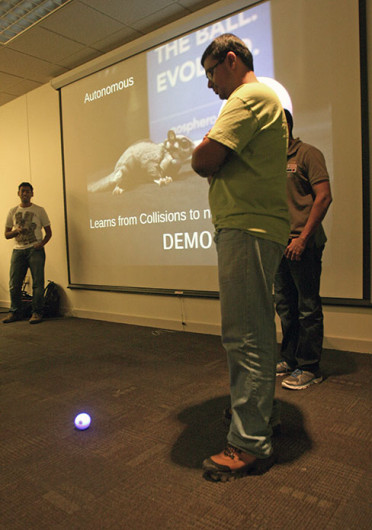
Sudharshan Muralidharan, a first-year graduate student in computer science, acts as an “obstacle” for a Sphero 2.0.
Credit: Shelby Lum / Photo editor
Creating the perfect playlist for your friends can be hard. Creating a web application within 25 hours that uses Facebook, Wikipedia and Spotify to create that perfect mix, though, is a bit more challenging.
“It’s a very mind-numbing experience. I stayed up the whole night working on this,” said Ross Johnstal, a second-year in electrical engineering and leader of the team who created an application called “Atmosphere” that took first place in Ohio State’s first Hackathon.
The Hackathon, a 25-hour competition for students to build the best software project, was held in the basement of the 18th Avenue Library from 3 p.m. Saturday to 3 p.m. Sunday. Teams were able to work for an extra hour because of daylight saving time.
“The purpose is to create a hacker culture at Ohio State,” said Arnab Nandi, an assistant professor of computer science and engineering and an organizer of the event. He described a hacker culture as “a group of people who are excited about writing codes and software.”
The 34 groups of two to four members had from 4 p.m. Saturday until 1 p.m. Sunday to code, which means to write computer programs, and create some kind of usable software, said Meris Mandernach, head of research services in the Office of Academic Affairs. The projects had to be entirely built within this time frame using the team’s own devices.
Projects included a social networking site called “OSYou,” which would allow users to put their years and majors on their profiles about and connect with other students in their classes or with similar interests, and an OSU events website that aimed to catalog all student-organization-hosted events so students could find events based on interests.
Shashank Agarwal, a graduate student in computer science and engineering, and his teammate Amna Khan, a fifth-year also in computer science and engineering, developed the idea for the OSU events calendar. Agarwal said the Hackathon finally gave him the opportunity to build his project.
“I’ve had this idea for a long time, but homework, midterms, they all get in the way of building this thing,” he said. “Because of this event, I have made something that I myself would love to use.”
After the 1 p.m. deadline, each group was given five minutes to demonstrate their idea to the judges, which included three OSU faculty members and one representative each from computer software companies Teradata and Hortonworks. Teams were judged on creativity, utility in the real word, technical depth and how challenging the project was given the time frame.
The music application “Atmosphere” allowed users to select friends through Facebook before pulling information from their music “likes” and finding similar music from similar genres using Wikipedia. The program would then launch a personalized playlist in Spotify.
Johnstal’s teammate Ritvik Vasudevan, a second-year in mechanical engineering, said Johnstal’s research prior to the event contributed to their win.
“It was thoughtful preparation,” Ritvik said. “Everything (he) did was very thoughtful, very intentional, something that I think a lot of teams could have benefitted from.”
The prizes for the top three placing groups were Parrot AR.Drone 2.0 Wifi Quadricopters, worth about $300 on Amazon, Nexus 7 tablets, worth more than $200 on Amazon, and Sphero 2.0 robotic ball, worth roughly $130 on Amazon, respectively.
However, prizes were not the only things competitors could gain from the experience. Nandi said some students could find potential internship or job opportunities with some companies that attended the event, which included Teradata and Hortonworks.
“(From the demonstrations) we are expecting the industry folks would have seen who are the good students and who had the most impressive demos,” Nandi said. “It’s a great networking opportunity.”
The event was organized by OSU Libraries, the Department of Computer and Science Engineering Database Research Group and the Ohio State Open Source Club. Undergraduate Student Government, the Department of Computer Science and Engineering and the College of Engineering provided food for the hackers, while Coca-Cola provided drinks. Prizes were provided by Teradata, Hortonworks and Google. Nandi estimated the total cost of the event with food and prizes to be about $10,000.


